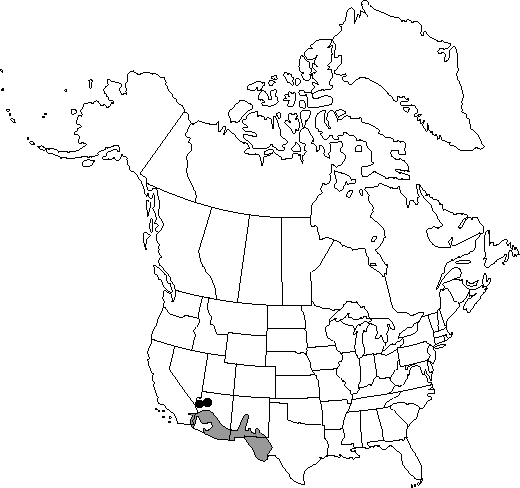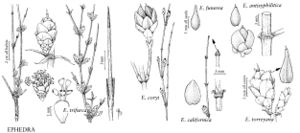FNA>Volume Importer |
imported>Volume Importer |
| (7 intermediate revisions by 2 users not shown) |
| Line 8: |
Line 8: |
| | }} | | }} |
| | |common_names=Mexican-tea | | |common_names=Mexican-tea |
| | + | |special_status={{Treatment/ID/Special_status |
| | + | |code=F |
| | + | |label=Illustrated |
| | + | }} |
| | |basionyms= | | |basionyms= |
| | |synonyms= | | |synonyms= |
| Line 17: |
Line 21: |
| | }}<!-- | | }}<!-- |
| | | | |
| − | --><span class="statement" id="st-d0_s0" data-properties="shrub orientation;shrub some measurement"><b>Shrubs </b>erect, 0.5–5 m.</span> <span class="statement" id="st-d0_s1" data-properties="bark coloration;bark condition;bark relief"><b>Bark </b>gray, cracked and irregularly fissured.</span> <span class="statement" id="st-d0_s2" data-properties="branch arrangement;branch arrangement;branch texture;angle degree"><b>Branches </b>alternate or whorled, rigid, angle of divergence about 30°.</span> <span class="statement" id="st-d0_s3" data-properties="twig coloration;twig coloration;twig coloration;twig pubescence;groove count;groove width;groove dehiscence or orientation"><b>Twigs </b>pale green, becoming yellow, then gray with age, glaucous, with numerous very fine longitudinal grooves;</span> <span class="statement" id="st-d0_s4" data-properties="internode some measurement">internodes 3–10 cm.</span> <span class="statement" id="st-d0_s5" data-properties="terminal bud shape;terminal bud some measurement"><b>Terminal </b>buds spinelike, to 10 mm.</span> <span class="statement" id="st-d0_s6" data-properties="leaf some measurement;leaf fusion;leaf length;whorl count"><b>Leaves </b>in whorls of 3, 5–15 mm, connate to 1/2–3/4 their length;</span> <span class="statement" id="st-d0_s7" data-properties="base coloration">bases becoming gray and shredded with age;</span> <span class="statement" id="st-d0_s8" data-properties="apex architecture or shape">apex spinose.</span> <span class="statement" id="st-d0_s9" data-properties="pollen cone count;pollen cone shape;pollen cone some measurement;peduncle height or length or size;peduncle architecture or pubescence"><b>Pollen </b>cones 1–several at node, obovoid, 6–10 mm, on short, scaly peduncles;</span> <span class="statement" id="st-d0_s10" data-properties="bract coloration;bract shape;bract shape;bract length;bract width;bract texture;whorl count;whorl count">bracts in 8–12 whorls of 3, reddish-brown, obovate, slightly clawed, 3–4 × 2–3 mm, membranous;</span> <span class="statement" id="st-d0_s11" data-properties="bract variability">bracteoles nearly equaling bracts;</span> <span class="statement" id="st-d0_s12" data-properties="sporangiophore some measurement;sporangiophore position;sporangiophore length;microsporangium count;microsporangium architecture">sporangiophores 4–5 mm, exserted to 1/4 their length, with 4–5 short-stalked microsporangia.</span> <span class="statement" id="st-d0_s13" data-properties="seed-cone count;seed-cone shape;seed-cone distance;peduncle height or length or size;peduncle architecture or pubescence"><b>Seed-</b>cones 1–several at node, obovoid, 10–15 mm, on short, scaly peduncles (rarely sessile);</span> <span class="statement" id="st-d0_s14" data-properties="bract arrangement or shape;bract length;bract width;bract texture;bract coloration or reflectance;whorl count;whorl count;center coloration;base shape;margin architecture or shape">bracts in 6–9 whorls of 3, circular, 8–12 × 8–12 mm, papery, translucent with reddish-brown center and base, base clawed, margins entire.</span> <span class="statement" id="st-d0_s15" data-properties="seed atypical count;seed count;seed shape;seed length;seed width;seed coloration;seed architecture or pubescence or relief"><b>Seeds </b>1 (–3), ellipsoid, 8–15 × 1.5–3 mm, light-brown, smooth.</span><!-- | + | --><span class="statement" id="st-undefined" data-properties=""><b>Shrubs </b>erect, 0.5–5 m. <b>Bark</b> gray, cracked and irregularly fissured. <b>Branches</b> alternate or whorled, rigid, angle of divergence about 30°. <b>Twigs</b> pale green, becoming yellow, then gray with age, glaucous, with numerous very fine longitudinal grooves; internodes 3–10 cm. <b>Terminal</b> buds spinelike, to 10 mm. <b>Leaves</b> in whorls of 3, 5–15 mm, connate to 1/2–3/4 their length; bases becoming gray and shredded with age; apex spinose. <b>Pollen</b> cones 1–several at node, obovoid, 6–10 mm, on short, scaly peduncles; bracts in 8–12 whorls of 3, reddish brown, obovate, slightly clawed, 3–4 × 2–3 mm, membranous; bracteoles nearly equaling bracts; sporangiophores 4–5 mm, exserted to 1/4 their length, with 4–5 short-stalked microsporangia. <b>Seed</b> cones 1–several at node, obovoid, 10–15 mm, on short, scaly peduncles (rarely sessile); bracts in 6–9 whorls of 3, circular, 8–12 × 8–12 mm, papery, translucent with reddish brown center and base, base clawed, margins entire. <b>Seeds</b> 1(–3), ellipsoid, 8–15 × 1.5–3 mm, light brown, smooth.</span><!-- |
| | | | |
| | -->{{Treatment/Body | | -->{{Treatment/Body |
| | + | |phenology=Coning late winter–early spring. |
| | |habitat=Dry rocky slopes to flat sandy areas | | |habitat=Dry rocky slopes to flat sandy areas |
| | |elevation=500–2000 m | | |elevation=500–2000 m |
| | |distribution=Ariz.;Calif.;N.Mex.;Tex.;Mexico in Baja California;Chihuahua;Coahuila;Sonora. | | |distribution=Ariz.;Calif.;N.Mex.;Tex.;Mexico in Baja California;Chihuahua;Coahuila;Sonora. |
| − | |discussion=<p>The hybrid Ephedra × intermixta is discussed under E. torreyana.</p> | + | |discussion=<p>The hybrid <i>Ephedra</i> × intermixta is discussed under <i>E. torreyana</i>.</p> |
| | |tables= | | |tables= |
| | |references= | | |references= |
| Line 32: |
Line 37: |
| | -->{{#Taxon: | | -->{{#Taxon: |
| | name=Ephedra trifurca | | name=Ephedra trifurca |
| − | |author=
| |
| | |authority=Torrey ex S. Watson | | |authority=Torrey ex S. Watson |
| | |rank=species | | |rank=species |
| Line 39: |
Line 43: |
| | |basionyms= | | |basionyms= |
| | |family=Ephedraceae | | |family=Ephedraceae |
| | + | |phenology=Coning late winter–early spring. |
| | |habitat=Dry rocky slopes to flat sandy areas | | |habitat=Dry rocky slopes to flat sandy areas |
| | |elevation=500–2000 m | | |elevation=500–2000 m |
| Line 45: |
Line 50: |
| | |publication title=Botany (Fortieth Parallel): | | |publication title=Botany (Fortieth Parallel): |
| | |publication year=1871 | | |publication year=1871 |
| − | |special status= | + | |special status=Illustrated |
| − | |source xml=https://jpend@bitbucket.org/aafc-mbb/fna-fine-grained-xml.git/src/287ef3db526bd807d435a3c7423ef2df1e951227/V2/V2_18.xml | + | |source xml=https://bitbucket.org/aafc-mbb/fna-data-curation/src/2e0870ddd59836b60bcf96646a41e87ea5a5943a/coarse_grained_fna_xml/V2/V2_18.xml |
| | |genus=Ephedra | | |genus=Ephedra |
| | |species=Ephedra trifurca | | |species=Ephedra trifurca |
| − | |angle degree=30°
| |
| − | |apex architecture or shape=spinose
| |
| − | |bark coloration=gray
| |
| − | |bark condition=cracked
| |
| − | |bark relief=fissured
| |
| − | |base coloration=gray
| |
| − | |base shape=clawed
| |
| − | |bract arrangement or shape=circular
| |
| − | |bract coloration=reddish-brown
| |
| − | |bract coloration or reflectance=translucent
| |
| − | |bract length=8mm;12mm
| |
| − | |bract shape=clawed;obovate
| |
| − | |bract texture=papery;membranous
| |
| − | |bract variability=equaling
| |
| − | |bract width=8mm;12mm
| |
| − | |branch arrangement=whorled;alternate
| |
| − | |branch texture=rigid
| |
| − | |center coloration=reddish-brown
| |
| − | |groove count=numerous
| |
| − | |groove dehiscence or orientation=longitudinal
| |
| − | |groove width=fine
| |
| − | |internode some measurement=3cm;10cm
| |
| − | |leaf fusion=connate
| |
| − | |leaf length=0;1/2-3/4
| |
| − | |leaf some measurement=5mm;15mm
| |
| − | |margin architecture or shape=entire
| |
| − | |microsporangium architecture=short-stalked
| |
| − | |microsporangium count=4;5
| |
| − | |peduncle architecture or pubescence=scaly;scaly
| |
| − | |peduncle height or length or size=short;short
| |
| − | |pollen cone count=1;several
| |
| − | |pollen cone shape=obovoid
| |
| − | |pollen cone some measurement=6mm;10mm
| |
| − | |seed architecture or pubescence or relief=smooth
| |
| − | |seed atypical count=1;3
| |
| − | |seed coloration=light-brown
| |
| − | |seed count=1
| |
| − | |seed length=8mm;15mm
| |
| − | |seed shape=ellipsoid
| |
| − | |seed width=1.5mm;3mm
| |
| − | |seed-cone count=1;several
| |
| − | |seed-cone distance=10mm;15mm
| |
| − | |seed-cone shape=obovoid
| |
| − | |shrub orientation=erect
| |
| − | |shrub some measurement=0.5m;5m
| |
| − | |sporangiophore length=1/4
| |
| − | |sporangiophore position=exserted
| |
| − | |sporangiophore some measurement=4mm;5mm
| |
| − | |terminal bud shape=spinelike
| |
| − | |terminal bud some measurement=0mm;10mm
| |
| − | |twig coloration=gray;yellow;pale green
| |
| − | |twig pubescence=glaucous
| |
| − | |whorl count=3;6;9
| |
| | }}<!-- | | }}<!-- |
| | | | |
| | -->[[Category:Treatment]][[Category:Ephedra]] | | -->[[Category:Treatment]][[Category:Ephedra]] |
Shrubs erect, 0.5–5 m. Bark gray, cracked and irregularly fissured. Branches alternate or whorled, rigid, angle of divergence about 30°. Twigs pale green, becoming yellow, then gray with age, glaucous, with numerous very fine longitudinal grooves; internodes 3–10 cm. Terminal buds spinelike, to 10 mm. Leaves in whorls of 3, 5–15 mm, connate to 1/2–3/4 their length; bases becoming gray and shredded with age; apex spinose. Pollen cones 1–several at node, obovoid, 6–10 mm, on short, scaly peduncles; bracts in 8–12 whorls of 3, reddish brown, obovate, slightly clawed, 3–4 × 2–3 mm, membranous; bracteoles nearly equaling bracts; sporangiophores 4–5 mm, exserted to 1/4 their length, with 4–5 short-stalked microsporangia. Seed cones 1–several at node, obovoid, 10–15 mm, on short, scaly peduncles (rarely sessile); bracts in 6–9 whorls of 3, circular, 8–12 × 8–12 mm, papery, translucent with reddish brown center and base, base clawed, margins entire. Seeds 1(–3), ellipsoid, 8–15 × 1.5–3 mm, light brown, smooth.
Phenology: Coning late winter–early spring.
Habitat: Dry rocky slopes to flat sandy areas
Elevation: 500–2000 m
Distribution
Ariz., Calif., N.Mex., Tex., Mexico in Baja California, Chihuahua, Coahuila, Sonora.
Discussion
The hybrid Ephedra × intermixta is discussed under E. torreyana.
Selected References
None.

